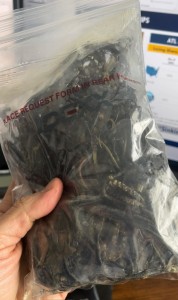Diaper Cream and Hair Ties – A Poisonous Combination
 Anyone with a Golden Retriever knows they like to put things in their mouths and chew them. So, when Kim Manzo of Fort Mill, South Carolina, found that her six-year-old dog Sawyer had gotten into her child’s diaper cream, she wasn’t too concerned.
Anyone with a Golden Retriever knows they like to put things in their mouths and chew them. So, when Kim Manzo of Fort Mill, South Carolina, found that her six-year-old dog Sawyer had gotten into her child’s diaper cream, she wasn’t too concerned.
“Sawyer woke us up in the middle of the night on a Thursday vomiting white stuff, which we soon figured out was ointment from a tube of diaper cream containing zinc oxide,” Manzo explained. “He hadn’t pierced the tube, but had squeezed out and consumed all the cream. He had never gotten into it before, but we figured he would throw it up and be fine. The next morning, Friday, he was still really sick, so we called the veterinarian. They suggested we call Pet Poison Helpline before bringing Sawyer to the clinic, so the toxicologists could develop a treatment plan.”
Given the amount of cream Sawyer had ingested, the fact that he had vomited up a large amount of the material, and the amount of time since consumption, both the veterinary office and the team at Pet Poison Helpline believed that the ingestion shouldn’t be of concern. They recommended monitoring Sawyer at home since most dogs feel better the following day, and take him into the hospital for an evaluation if he did not improve throughout the day.
On Sunday, Sawyer was still not feeling well and was very lethargic, so Manzo took him to an emergency veterinary hospital which did an x-ray, but the veterinarian originally thought an image he saw was simply food in his stomach. On Monday, the veterinarian called Manzo back and explained there might be something lodged in Sawyer’s stomach. He recommended another visit to the hospital, so this time Manzo drove him about 30 minutes to the Veterinary Emergency Group (VEG) in Charlotte, where they took more x-rays and did an ultrasound.
“When the medical team at VEG Charlotte reviewed the new x-rays, they saw some type of foreign body in his stomach which may have been contributing to Sawyer’s clinical signs,” said Dr. Renee Schmid, a senior veterinary toxicologist at Pet Poison Helpline. “When they performed surgery, they found a large number of hair ties that were holding a moderate amount of the zinc oxide cream in the stomach.”
“They pulled out what looked like several hundred of my black hair ties,” Manzo exclaimed. “If you hold your arms out, you could fill both hands with what they removed. You know how you lose things? Well, apparently Sawyer had been eating my ties over the past several years, and they all got caught in his stomach. Because they went missing one at a time, I had just simply replaced them without really thinking about where they had gone.”
After the surgery, Sawyer went home to his family expecting to make a full recovery. On Tuesday, however, he started having dark red urine.
“Initially we thought he might have a urinary tract infection (UTI), so we continued monitoring him,” Manzo added. “The next morning, he still wasn’t doing well so we took him back to VEG, and his red blood cell levels had decreased. He was showing signs of zinc oxide poisoning, but it normally wouldn’t be expected after his vomiting and surgery.”
The toxicology experts at Pet Poison Helpline speculate that the diaper cream must have adhered to the wad of hair ties, so the zinc oxide remained in his stomach at a dangerous level and continued to poison his system even after he vomited up a portion of the material. At that point they decided to give Sawyer a blood transfusion due to the zinc oxide causing a destruction of Sawyer’s red blood cells leading to anemia (lower than normal red blood cell concentration).
Zinc poisoning from diaper rash cream is very rare due to the typically low concentration of zinc oxide and ingesting the cream makes most pets vomit on their own, ridding their body of the potential toxin. In Sawyer’s case, since the diaper rash cream was adhered to the ties in the stomach for several days, the zinc was able to be absorbed and cause poisoning, similar to what we would see after a penny ingestion. In most cases, pets will develop vomiting and possibly a decreased appetite, both which typically resolve on their own without the need for medical intervention. When the zinc source is left in the stomach for a prolonged period of time, more severe poisoning can occur including hemolysis (destruction of red blood cells), anemia, severe gastrointestinal irritation and organ damage.
“After two blood transfusions, Sawyer’s red blood cell concentration finally returned to normal,” Dr. Schmid added. “As if he hadn’t already been through enough, Sawyer’s incision from surgery then became infected and he needed to be treated with antibiotics. Fortunately, his incision healed, his body was able to regenerate red blood cells on its own so he did not require more transfusions, and he made a full recovery.”
“It was a long and expensive ordeal that started with a plastic tube of butt cream,” Manzo joked. What wasn’t a joke was the cost. “We spent nearly $16,000 on treatment, which we would do again, so I would highly recommend pet insurance.”
Source: Pet Poison Helpline
Pet Poison Helpline created Toxin Tails to educate the veterinary community and pet lovers on the many types of poisoning dangers facing pets, both in and out of the home. All the pets highlighted in Toxin Tails have been successfully treated for the poisoning and fully recovered.
Short URL: http://caninechronicle.com/?p=279429
Comments are closed












